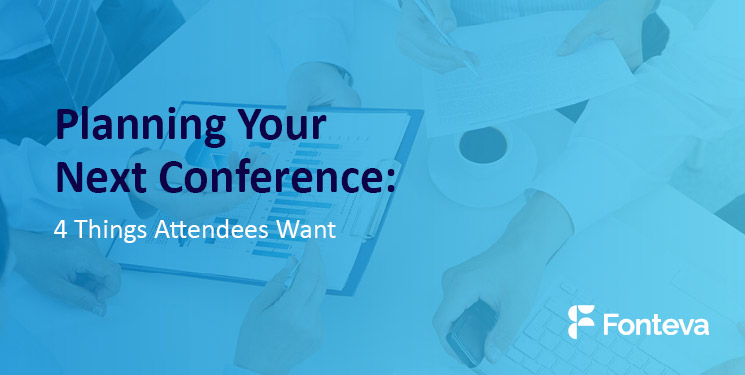
by Guest Author | Feb 13, 2020 | Blog
|
If planned successfully, your conference should attract a group of like-minded people and offer a unique experience that they can’t get anywhere else. Whether it’s a professional or academic conference geared toward associations or nonprofits, people are ultimately registering to network and learn from others like them.
Conferences are also becoming very popular to host, so it might take more than just a simple announcement to garner enough registrants. With ongoing technological innovations and modern event planning tools automating a good amount of manual tasks, it can be tricky to determine the best way to attract attendees.
A good school of thought is to always consider what your attendees want. According to Fonteva, your event management software can offer a wide variety of tools to empower your guests and give them more flexibility to optimize their own experience.
|
If you don’t know where to start, there’s no need to stress! In this guide, you’ll learn about the many ways you can go the extra mile, enhance your conference, and attract more attendees:
|
Learn the best ways to elevate your conference and ensure that your attendees have the best experience possible. Ready to clear up what your event guests want? Let’s get started!

1. Host a dedicated conference website.
Conference planning should start months before the actual event date. Once you have a good sense of the venue, vendors, speakers, and sessions, it’s time to announce it! To get the word out, you should develop an event marketing strategy.
A great way to kickstart event registration is to announce your conference online. While you’re likely already distributing an email newsletter and posting about it on your organization’s main
website, an effective way to make your conference more accessible and attention-grabbing is to create a dedicated website for it.
Many organizations will build a micro-site to promote their event and serve as a hub for all relevant details. This is an individual webpage that is associated with the main site but can function as its own entity. A page that is dedicated specifically for the event is beneficial since potential attendees are likely searching online to learn more.
On your dedicated conference event page, you can:
- Host all necessary details and event information.
- Accept registrations and sell tickets.
- Track leads and gain better insights into how people find your event.
- Sell merchandise on an eStore. For example, you can sell t-shirts as a fundraiser.
Make it easy for your guests to learn about your event and register. Additionally, guests can easily share the link with others and help spread the word! Read on to learn what to do once you get people on the website.
Back to Top of Post

2. Offer flexible registration options.
Even after you make your conference website aesthetically pleasing and easy to navigate, “shopping cart abandonment” can happen for many reasons. You don’t want your online registration process to ultimately turn attendees away. Luckily, there are a couple of steps you can take to prevent this from happening.
Take a look at your event management tools and consider how your online registration can be more efficient and better meet prospective attendees’ needs. For starters, it’s important that your registration form is branded and customized to your specific conference.
Many software solutions provide form templates to help event planners improve their registration process. While this is helpful, you should also ensure that you can tailor the questions. This means eliminating questions that aren’t applicable, making certain fields optional, and providing all necessary event forms and waivers.
In addition, it’s critical to empower prospective attendees to choose how they want to register for and experience your conference. Flexible registration options will boost the chances of registration completion. Here’s what you can offer:
- Varying packages and registration levels. Give guests the option to upgrade or downgrade their registration level. This means VIP status!
- Group registration. If you’re a manager and in charge of registering your entire department, don’t stress. With group registration options, one person can register multiple people without entering the same attendee data and payment information multiple times.
- Exclusive deals. Give special registrants, like individuals who recently made a large donation or are active supporters of your organization, deals like a discount or early-bird registration!
- Member perks. If your organization is a member-based association, offer member-exclusive perks. Whether it’s discounts or incentives, this is a great way to keep members engaged. Learn
more about this topic.
- Event series and multi-session selector. Ensure that your management tool can handle all types of registration, including a series of events where attendees register for them all at once. On the other side of the spectrum, you can allow users to pick and choose their desired sessions in a multi-session event.
The more flexible your registration is, the more members you will resonate with. Take a look at your event registration tool and consider all of the ways you can leverage it to make your registrants’ lives easier.
Back to Top of Post

3. Boost convenience with a mobile conference app.
A great way to attract more guests to your conference and keep them engaged on-site is to offer a mobile event app. With 96% of Americans owning a mobile device, incorporating a mobile app into your event can create a more connected and convenient experience.
Creating a mobile conference app doesn’t mean you need to contact a professional coder and start from scratch. According to this Pathable article, there is an abundance of event app providers that can help you create one for your conference.
However, depending on your event management tool, you might be able to provide a mobile event app within your existing solution. With a capable mobile event app, your conference guests can:
- Access all event details. It’s likely that your conference has a wide range of speakers, vendors, and activities. From the convenience of their mobile phones, let guests view important information like a timeline or the conference’s schedule.
- Contribute to a community forum. A mobile event app is a great place to host some sort of online forum or discussion board. Conference attendees can engage with each other and interact online.
- Receive urgent announcements. When you plan a conference, you can’t always predict speaker cancellations or other last-minute changes. Through the mobile event app, you can easily notify attendees of any updates.
- Contact customer service. Your attendees might have questions or need to talk to a staff member. Empower them to contact customer service through the mobile app so they can easily receive assistance whenever and wherever.
- Give feedback. As soon as your conference comes to an end, send out a survey through your mobile conference app. This is a great way to gain constructive event feedback while it’s still fresh in their minds.
A mobile event app not only creates a direct connection with your attendees but also provides them with intuitive tools to better navigate your conference. An optimized attendee experience is the best way to increase registration.
Back to Top of Post

4. Provide a conference schedule builder.
Conferences are packed with various learning experiences that aim to bring like-minded people together, so you’ve likely worked hard inviting relevant speakers and coordinating valuable activities and sessions.
For instance, if you planned an educational conference, all of your guests are likely academic professionals and work in some type of educational institution. With your event management tool, you can easily book speakers who are widely known in the academic world and provide multiple sessions hosted by education leaders.
To further attract attendees and make the conference experience as enjoyable as possible, let guests build their own conference schedule out of the variety of activities and sessions you’re hosting. This gives your guests ownership and control of their personal conference experience, ensuring that they’re able to enjoy the event.
Let conference attendees edit their schedules and access them from the mobile event app. This way, they won’t miss out on an activity and can check up on it whenever they need to. If there are multiple sessions that a guest wants to attend at once, it can be beneficial to do some on-site recording and allow attendees to view it after the conference is over!
Back to Top of Post
As you begin to think about your next conference, make sure you’re especially considerate about your attendees’ specific needs. Put in the effort to empower your guests and provide them with the tools they need to enjoy your conference the way they want. Good luck!
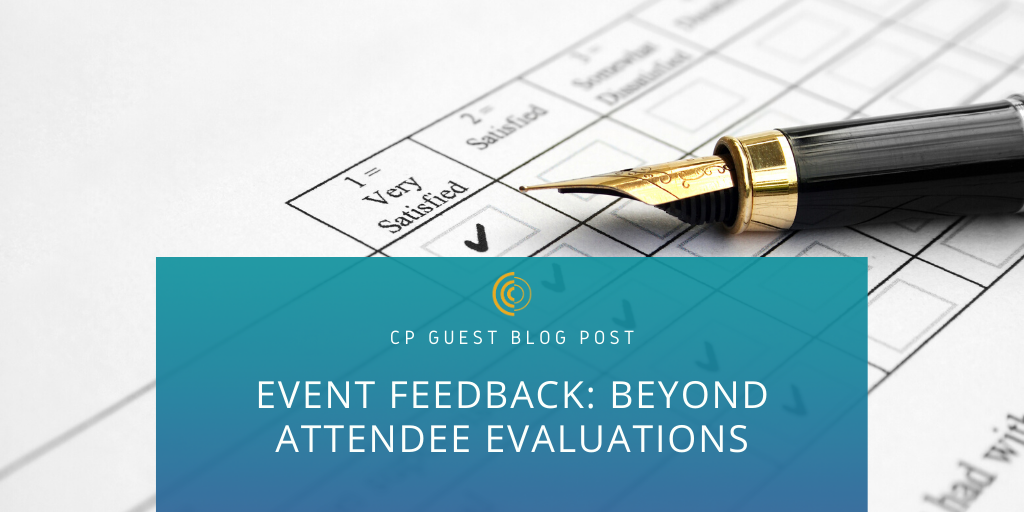
by Guest Author | Jan 14, 2020 | Blog
Event Feedback: Beyond Attendee Evaluations
Organizations of all sizes and interest groups can benefit from hosting or sponsoring live conferences and events. They help you connect your people with each other and with information. They’re also a great way to learn about the latest and greatest tools for your business, build your network, and foster community among industry professionals.
Creating an unforgettable event experience requires, first and foremost, establishing standards for success. What does a great event look like, and how will you know how yours measures up? Collecting feedback from conference attendees is an important part of defining the results of your event. This is true whether you’re hosting a live in-person conference, virtual event, or hybrid with a livestream component, as is increasingly popular among associations and nonprofit organizations.
Evaluations, sometimes called “evals” for short, are but one method to collect attendee feedback. We’ll explore a few other ways to gauge the impact of your event or conference:

1. Live Polls

2. Surveys

3. Gamification
Live Polls
Imagine for a moment that you could capture feedback instantly and use that information to change the course of your event mid-stream. What would it mean if you could harness that real-time data and apply it to drive engagement among your audience, while they’re still onsite/online?
Live polls are a unique way to get feedback from conference-goers that can empower you to take action in the moment versus waiting until your next event to apply the learning.
Maybe you have a major keynote speaker scheduled to take the stage in the afternoon, but general session attendance was poor earlier in the day. Before the big afternoon keynote, you could call attendees’ attention to a poll (using email or your event app) about what topic they’d most like to see from the upcoming speaker. Or have them vote on two impromptu topics and have your speaker lead with insights gleaned from the poll results as an icebreaker.
Or, better yet, your speaker could incorporate a live poll into his or her presentation. This gives your audience a part to play in the experience and helps connect them to the speaker’s message— both can positively impact their overall perception of the event. You’re engaging them, making them part of the experience, and showing them that you care about what they think.
Surveys
Structurally speaking, a survey is basically a group of polls. It’s a set of questions with predetermined answer options that help you collect and organize feedback from your audience. Surveys are frequently used in pre- and post-event contexts to help event planners analyze the impact of the event on attendee perception.
Do your people feel differently about your organization or brand before they attended their last breakout session than they did when they arrived on Day 1? Did they attend your conference to get insights they can apply right away to their business (pre-event), and were their expectations met (post-event)?
Surveys can be used across your event in as many innocuous ways (was the coffee hot enough?) as indicative ones (how likely are you to enlist our services in the future?). By focusing your questions around key indicators of success you’ll capture the right data to help you improve with each event delivery.
Gamification
You’re halfway through Day 2 of your event and everything onsite is going great. Then you look around and, all of a sudden, you see your attendees are completely distracted. They won’t look up from their phones and the presenter you’ve invited to speak knows it. Instead of taking this cringeworthy moment as a failure or a fluke, consider it an opportunity. Make a game of it!
Another burgeoning method for engaging attendees and collecting their feedback at events is through gamification. This is a concept born out of the human desire to play while learning (yes, even at work) and technology’s power to enable that behavior.
Challenge your people to a friendly competition to see who can complete their session surveys the soonest. Offer a prize to the top five people who visit the greatest number of sponsors. Watch as the number of private meetings booked increases after you incentivize peer-to-peer and attendee-expert networking. Encourage them to team up with colleagues and spread the word.
These are just a few examples to engage the audience at your next event or conference. Be sure to check out EventMB Studio’s “15 Ideas to Collect Feedback at Events” for other creative ways to find out what attendees really think about your event.
ABOUT THE AUTHOR: Maggie Greene, Pathable, Inc.

Equal parts voracious reader and passionate writer, Maggie is an expert in communication principles and practices that help drive positive impact for business. As Marketing Manager for Pathable, Inc., she’s customer-obsessed, results-oriented, and dedicated to celebrating the value of highly customizable event app and web solutions for event planners across industries around the globe.
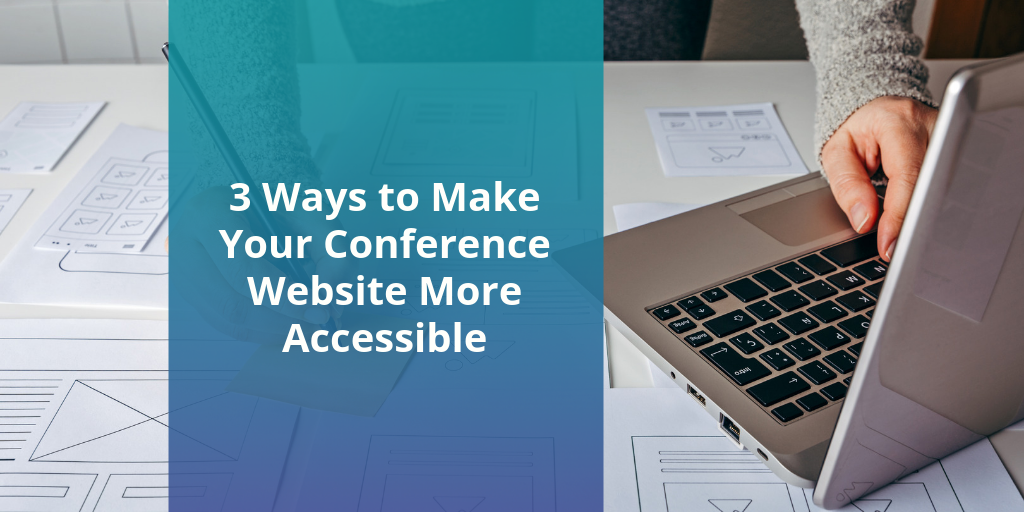
by Guest Author | Aug 19, 2019 | Blog
In the past five years there has been increased focus from technology companies on making their Web based applications accessible to all participants. At CommPartners, we recently teamed with eSSENTIAL Accessibility to provide assisted technologies to support access and usage of our Elevate LMS to those with physical challenges. In that spirit we are pleased to post this blog from Michael Doane, Marketing Manager at Cadmium CD.
Conferences and trade shows provide education and opportunity to a wide range of people with different abilities. It is more important than ever to make sure these people can access the full range of opportunities your event has to offer, both online and onsite. That’s why many tech companies are embracing website accessibility standards like WCAG 2.1.
Michelle Wyatt, CadmiumCD co-founder and CEO, says, “As a software company that services and supports global users with various backgrounds and needs, we take it as our duty to uphold this mission to the best of our ability.”
What is WCAG 2.1 AA Accessibility?
According to the World Wide Web Consortium (W3C), “Web Content Accessibility Guidelines (WCAG) 2.1 covers a wide range of recommendations for making Web content more accessible.” Its goal is to, “make content more accessible to a wider range of people with disabilities, including accommodations for blindness and low vision, deafness and hearing loss, limited movement, speech disabilities, photosensitivity, and combinations of these, and some accommodation for learning disabilities and cognitive limitations” (source).
Is compliance compulsory?
While these standards are not required by law for private companies, the EU does require all public sector websites to adhere to WCAG 2.1 equivalent standards (source). This includes products sold to or used by public sector organizations.
For now, US public sector sites only require 2.0 standard, but will likely adopt 2.1 standards in the near future as more organizations understand the need for modern accessibility standards.
Meghan Capiaghi, Lead Accessibility Developer, recently shared some tips on how CadmiumCD is making certain products more accessible (watch the recording).
Here are her 3 main tips on making your conference website more accessible:
1. Create Contrast on Your Site
Colors are an important factor for accessibility. To be truly accessible to those with visual impairments, your site must have a contract ratio of at least 4.5:1.
To determine if your selected colors meet the requirements, check out this website: https://webaim.org/resources/ contrastchecker/
2. Use Instructional Language
“Click this Button” makes no sense to someone who uses voice commands. Get creative with your language to reflect a wider audience. “Use this button” may be more appropriate.
3. Don’t Forget About PDFs
Do you share PDFs on your conference website site? Any documents linked from your site must also meet accessibility standards outlined by the W3C’s WCAG 2.1 initiative.
To learn more about how to create accessible documents, refer to this website: https://www.section508.gov/create
Additional Resources
- An introduction to WCAG 2.1 standards can be found on the W3C website.
- CadmiumCD has created a resource for clients who would like to uphold WCAG 2.1 Level AA standards, which can be accessed here.

About Michael Doane
Michael Doane is marketing manager at CadmiumCD, makers of the myCadmium software platform, an award-winning suite of conference and trade show management products. Visit the CadmiumCD blog for more articles like this.
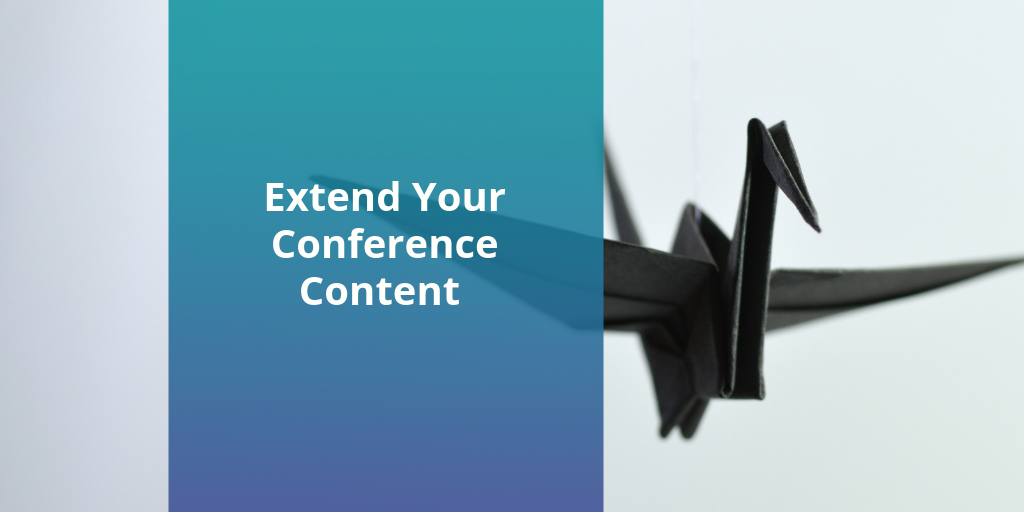
by Guest Author | Jun 26, 2019 | Blog
For associations, our annual conference is our flagship education product. Naturally we want to maximize our investment and extend the reach of this great content.
Unfortunately, most associations are doing it wrong.
It’s time to forget about repurposing and embrace PURPOSING.
But repurposing is efficient and responsible!
Repurposing suggests we can efficiently reuse components of education that has been delivered (past tense done) for additional meaningful learning opportunities. And we can’t. Example: Captured conference recordings are not good learning opportunities. Why? Because what’s been captured was designed for a learner in a live classroom learning space. Can someone be determined and dig in to learn something from a capture recording? Sure – but they will more likely google the subject than sit through an hour long video of a slide deck. Once removed from the classroom and situated in a virtual learning environment, we have different expectations of how we want to interact with content. Captured lecture is not designed to be chunked out or accessible in online learning environments. Would you ever create a Storyline eLearning course and expect participants at an in-person event should watch you click through it? (same same)
You can’t refold a crisp origami crane into a dragonfly – it won’t work. Each fold is put into place to achieve a particular design. Same with learning.
So you want an origami crane and a dragonfly. What do you do?
Three ideas
If your goal is to extend the learning of your conference, consider these opportunities.
1. Hybrid learning. Extend the reach of your conference to new audiences – perhaps your future live attendees. Craft a meaningful experience that incorporates not only streaming of select sessions, but live chat with those speakers and some hybrid-only content. Partner with solution providers like CommPartners who masterfully facilitate hybrid experiences.
Life cycle: This is an investment in cultivating future live attendees while extending the reach of the present conference. #winwin. You may also consider extending the learning via the desktop portal you create with your vendor partner for additional content drops.
2. Session tools. While attendees may request slide decks, what they really want are tools and resources (that they think they’ll have time to distill from session presentation visuals). Instead of collecting PowerPoints and Prezis, request your speakers submit a tip sheet, job aid, checklist, how-to guide, model, or process distilling their insights into a useful resource attendees can use and share. I call these Transformational Learning Tools because they are easy to deliver and are supremely valuable to participants (see driver #23 in my book Competitive Advantage to learn more).
Life cycle: While these begin as conference session handouts, they become a powerful catalyst for workplace impact. Consider the potential referrals as tools branded to your association are passed around teams because of their value. Imagine the online resource library you could build with these tools that would become indispensable to your members. Think about how you could assess downloads to determine content priorities for future education offerings.
3. Touch points. Let’s free our education from product silos delivering one-offs and deploy learning that touches our members over a period of time through different channels – reaching them where they are. Allow all of your education vehicles to participate in threading your association’s content priorities through learning pathways that beautifully highlight different facets of a subject through a variety of learning experiences. A few examples:
- Publish an article that leads to a live education session that’s followed up by a webinar punctuated by an email sharing a valuable job aid.
- Facilitate a social media conversation about a hot topic, host a thought leader session at your conference from which you derive a handy white paper that you can then distribute through your social media channels.
- Craft an online course that pulls participants together for a live skill-building experience, followed by an eMentorship that leads to a certificate.
The possibilities are endless!
Life cycle: You decide! Your touch points on a topic could be three or could thread throughout an entire year. Extend the learning from your conference by making it a part of a broader education delivery strategy.
A word about the elephant nearby
I don’t mean to beat up on capture products. I’ve produced conference capture products. Members ask for them and we think we need to deliver them. We don’t. This is not how we actively learn on devices. If you’re going to capture content at your conference, capture it with the future mode of delivery in mind.
- Consider capturing faculty commentary on their session. Pair the recording with an article or use it to stimulate a webinar conversation.
- Consider capturing hallway insights from attendees – testimonials you can drop throughout the year to build momentum for your next event – but also a formative assessment for your association to see what is resonating with your attendees.
- Capture how-to’s from your session speakers – brief clips distilled from their presentations that you can use to build a library of insights.
- Ted Talk style presentations transition well onto devices. If you’re delivering them, capture them for sure.
Extending your conference content is not about repurposing what’s been designed and delivered for the big gathering. It’s about pausing to plan in advance how you can capitalize on the gathering to draw out content you can continue delivering all year long.
Ready to strategically innovate your learning programs? We understand the challenge of change. Our secret weapon is an innovation framework based in psychology and behavioral neuroscience that’s a game changer for our clients. Coordinate a conversation at www.talktotracyking.com
Tracy King, MA, CAE
As CEO & Chief Learning Strategist of InspirEd, Tracy King leverages her more than 20 years in the industry consulting with organizations on education strategy and learning design. Tracy is the author of Competitive Advantage, and she advises associations on growing reliably profitable and sustainable CE programs that transform learners. Tracy specializes in the intersection of learning science and technology; her instructional design team produces engaging, inclusive, and transformational learning experiences. She’s a thought leader, invited speaker, master strategist, award winning learning designer and DELP Scholar. For more information please visit her online at www.inspired-ed.com
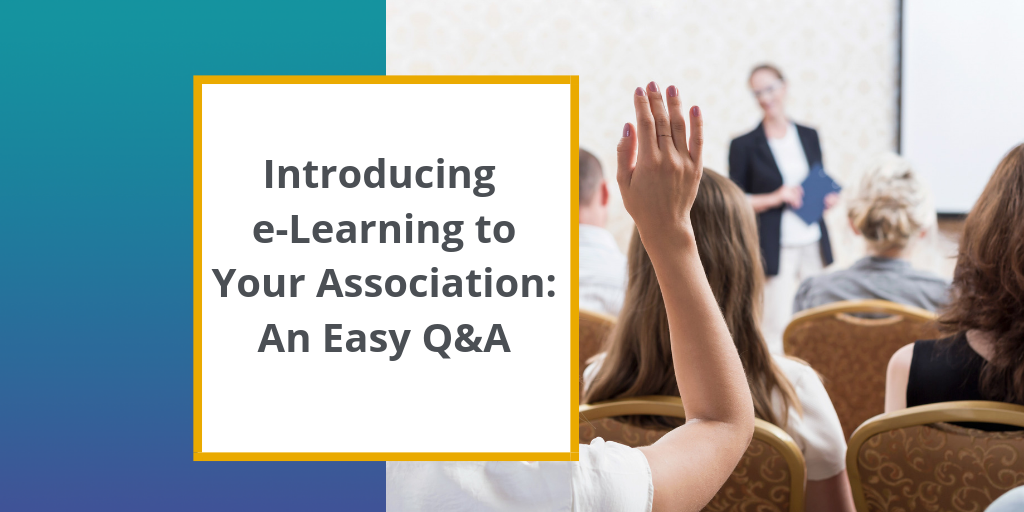
by Guest Author | Jun 10, 2019 | Blog
Jake Fabbri, Chief Marketing Officer at Fonteva, provides his perspective on prioritizing a well-conceived approach to education design and selecting the ideal LMS for your organization. CommPartners and Fonteva understand to achieve success with one’s learning initiatives, it’s important to have a seamless integration between your AMS and LMS. We appreciate Fonteva’s focus on education as a component of an organization’s online presence and value their contributions to the field of online education.
Your association’s favorite job is providing value to your members in a variety of different ways. Some associations hold conferences, others hold networking nights, and others do both. But one new technology makes it easier to engage your members and provide value to them in an engaging and exciting way.
That way is through e-learning! Like with any new technology, implementing a learning management system (LMS) into your association’s member engagement strategy can be a complex process. That’s why we’ve created a list of some of the most common questions that your staff or members may ask:
- How does a learning management system work?
- What are the differences between an LMS, an LCMS, and a CMS?
- What features does our staff need in an LMS?
- What features do our members need in an LMS?
Armed with the answers to these questions, you’ll be more prepared to integrate your new e-learning software into your association’s strategies and help your members further their careers.
1. How does a learning management system work?
When you first introduce a learning management system into your association’s offerings, you’ll likely be met with a lot of questions. The first is, “How does this work?”
A learning management system works by creating an interface where instructors and members can both log on to watch webinars, read articles, submit their own work, and interact with other members and instructors.
There are usually three different types of logins:
- Student or member logins. This level of access allows members to pick courses they want to complete, view their learning history and transcript, and work towards completing their coursework.
- Instructor logins. This level of access allows instructors to view their learners’ work, grade assignments, upload or edit course documents, and post videos or host webinars.
- Administrator logins. This level of access is for those who create the courses. In this position, your staffers can create and edit courses and view trends in attendance, popularity, and more.
Your learning management software should integrate with your association management software, so that the LMS acts as an extension of your AMS and your member data can flow easily between the two systems.
2. What are the differences between an LMS, an LCMS, and a CMS?
These three acronyms, while all important to the learning management industry, vary between their functionalities and their target users.
- An LMS is a learning management system. It is primarily used in professional training and higher education settings. An LMS is focused on providing training for certain topics while empowering the administrator to track progress, completion, deadlines, and objectives.
- An LCMS is a learning content management system. The main difference between this and an LMS is that the primary user of an LCMS is the course creator. An LCMS is used primarily to create, save, and organize different e-learning courses. It allows multiple authors to work together to create one course that is then available in a variety of formats.
- A CMS is a content management system. This system is less specifically geared towards e-learning and more towards information publication and distribution. CMS platforms allow the administrator to decide what is private and public information while allowing you to tailor access to both, but it is not focused on learning. WordPress and Hubspot are popular CMS platforms.
Your association should focus on finding and introducing the right LMS to your members.
3. What features does our staff need in an LMS?
When introducing a learning management system into your association’s strategy, you need to ensure that you’ve chosen one that can help your staff create the most effective and engaging courses possible. Simply put, you need to be able to track data and empower students.
In short, you need to have features that allow your staff to do what needs to be done easily and effectively. The most important features for your LMS are:
- Custom design capabilities.
- Brand matching capabilities.
- Seamless integrations.
- Comprehensive reporting.
- Customer support.
When purchasing an LMS, make a list of features that your individual association requires. Depending on your own members, industry, or size, you’ll have different needs than other groups, so make sure that you get the right LMS for you.
4. What features do our members need in an LMS?
The needs of your members will be different than the needs of your staffers because they’ll be interacting with your LMS in a different way! Keep these needs in mind when searching for the right set of features.
Your members will be more invested in the courses that your LMS offers if it allows them the freedom to do three things:
- Learn in the ways that are best for them.
- Interact with their peers.
- Gain something valuable towards their careers.
These three things are crucial to creating a strong e-learning strategy for your association. If your LMS doesn’t click with your members, they will be less likely to stick it out to the end of the course. In order to offer all of these options, look for the following features from your LMS provider:
- A personalized learner dashboard.
- Recommended content based on previous history.
- User profiles with interests and professions.
- Forums and discussion boards.
- Webinar and web conferencing options.
- SCORM compliance and CLE/CME/CE/CPE credits.
When your LMS encourages members to get involved, work alongside like-minded individuals, and further their own careers and ambitions, it will be far easier to introduce and implement an e-learning strategy into your association.
Author Bio: Jake Fabbri is the Chief Marketing Officer at Fonteva with over 18 years of experience working in marketing management. He has experience with lead generation, content marketing, marketing automation, and events.















